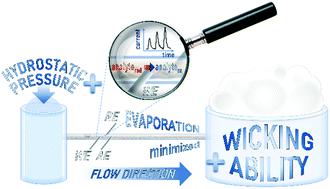Our official English website, www.x-mol.net, welcomes your feedback! (Note: you will need to create a separate account there.)
Threads in tubing: an innovative approach towards improved electrochemical thread-based microfluidic devices
Lab on a Chip ( IF 6.1 ) Pub Date : 2022-07-11 , DOI: 10.1039/d2lc00387b Ana Clara Maia Oliveira 1, 2 , Diele Aparecida Gouveia Araújo 1, 2 , Lauro Antonio Pradela-Filho 1, 2 , Regina Massako Takeuchi 1, 2 , Magno Aparecido Gonçalves Trindade 3 , André Luiz Dos Santos 1, 2
Lab on a Chip ( IF 6.1 ) Pub Date : 2022-07-11 , DOI: 10.1039/d2lc00387b Ana Clara Maia Oliveira 1, 2 , Diele Aparecida Gouveia Araújo 1, 2 , Lauro Antonio Pradela-Filho 1, 2 , Regina Massako Takeuchi 1, 2 , Magno Aparecido Gonçalves Trindade 3 , André Luiz Dos Santos 1, 2
Affiliation

|
Thread-based microfluidic analytical devices have received growing attention since threads have some advantages over other materials. Compared to paper, threads are also capable of spontaneously transporting fluid due to capillary action, but they have superior mechanical strength and do not require hydrophobic barriers. Therefore, thread-based microfluidic devices can be inexpensively fabricated with no need for external pumps or sophisticated microfabrication apparatus. Despite these outstanding features, achieving a controlled and continuous flow rate is still a challenging task, mainly due to fluid evaporation. Here, we overcome this challenge by inserting a cotton thread into a polyethylene tube aiming to minimize fluid evaporation. Also, a cotton piece was inserted into the outlet reservoir to improve the wicking ability of the device. This strategy enabled the fabrication of an innovative electrochemical thread in a tubing microfluidic device that was capable to hold a consistent flow rate (0.38 μL s−1) for prolonged periods, allowing up to 100 injections in a single device by simply replacing the cotton piece in the outlet reservoir. The proposed device displayed satisfactory analytical performance for selected model analytes (dopamine, hydrogen peroxide, and tert-butylhydroquinone), in addition to being successfully used for quantification of nitrite in spiked artificial saliva samples. Beyond the flow rate improvement, this “thread-in-tube” strategy ensured the protection of the fluid from external contamination while making it easier to connect the electrode array to the microchannels. Thus, we envision that the thread in a tube strategy could bring interesting improvements to thread-based microfluidic analytical devices.
中文翻译:

管道中的螺纹:一种改进基于电化学螺纹的微流体装置的创新方法
基于螺纹的微流控分析装置受到越来越多的关注,因为螺纹比其他材料具有一些优势。与纸相比,由于毛细作用,线还能够自发输送流体,但它们具有优越的机械强度并且不需要疏水屏障。因此,可以廉价地制造基于螺纹的微流体装置,而无需外部泵或复杂的微加工设备。尽管有这些突出的特点,但实现受控和连续的流速仍然是一项具有挑战性的任务,主要是由于流体蒸发。在这里,我们通过将棉线插入聚乙烯管中来克服这一挑战,旨在最大限度地减少流体蒸发。此外,将一块棉片插入出口储存器以提高装置的芯吸能力。-1 ) 长时间,只需更换出口储液罐中的棉片,即可在单个设备中进行多达 100 次注射。所提出的装置对选定的模型分析物(多巴胺、过氧化氢和叔丁基对苯二酚)表现出令人满意的分析性能,此外还成功地用于加标人工唾液样品中亚硝酸盐的定量。除了提高流速之外,这种“穿管式”策略还确保了保护流体免受外部污染,同时更容易将电极阵列连接到微通道。因此,我们设想管中的线程策略可以为基于线程的微流体分析设备带来有趣的改进。
更新日期:2022-07-14
中文翻译:

管道中的螺纹:一种改进基于电化学螺纹的微流体装置的创新方法
基于螺纹的微流控分析装置受到越来越多的关注,因为螺纹比其他材料具有一些优势。与纸相比,由于毛细作用,线还能够自发输送流体,但它们具有优越的机械强度并且不需要疏水屏障。因此,可以廉价地制造基于螺纹的微流体装置,而无需外部泵或复杂的微加工设备。尽管有这些突出的特点,但实现受控和连续的流速仍然是一项具有挑战性的任务,主要是由于流体蒸发。在这里,我们通过将棉线插入聚乙烯管中来克服这一挑战,旨在最大限度地减少流体蒸发。此外,将一块棉片插入出口储存器以提高装置的芯吸能力。-1 ) 长时间,只需更换出口储液罐中的棉片,即可在单个设备中进行多达 100 次注射。所提出的装置对选定的模型分析物(多巴胺、过氧化氢和叔丁基对苯二酚)表现出令人满意的分析性能,此外还成功地用于加标人工唾液样品中亚硝酸盐的定量。除了提高流速之外,这种“穿管式”策略还确保了保护流体免受外部污染,同时更容易将电极阵列连接到微通道。因此,我们设想管中的线程策略可以为基于线程的微流体分析设备带来有趣的改进。


























 京公网安备 11010802027423号
京公网安备 11010802027423号